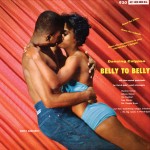His love for dance led Clarence Curvan from dancer to dance band leader. His entry into the world of music performance was unplanned, and may be described as accidental, but it opened the doors to an illustrious career. Following his passion for dancing, a teenage Curvan accompanied his mother and her friends to a party, which featured the Sonny Lewis Orchestra. Feeling out of place among the older crowd, he entertained himself by playing the cowbell along with the band. When he received the princely sum of $1 for his unsolicited night’s effort, he was encouraged to participate in subsequent engagements of the band on the invitation of Lewis, eventually becoming exceedingly proficient on the bongos.
His development as a bongo player sparked the interests of other bandleaders, and he was invited to join the Phil Britto Orchestra. Part of this band engagement schedule included weekly radio appearances, and many of the arrangements highlighted the bongos. This further enhanced Curvan’s reputation as a player, and he subsequently received an invitation from famed Calypso bandleader, Cyril Diaz, to play on recordings of Slinger Francisco, the Mighty Sparrow. A tour to the French Caribbean Isles afforded him additional opportunity to showcase his skills in a production entitled “Les Bongo Nuits.”
Having acquired this respect and reputation as a percussionist in his teenage years, Curvan jumped at the chance to put together a group of young musicians to fill a performance slot on a local radio station. This led to the formation of the Clarence Curvan Orchestra. He recalls the circumstances surrounding the band’s birth, and the musicians involved. Among them were Beverly Griffith, who played the piano and served as the band musical arranger, Stan Shaman on guitar, Kenrick George on bass, Philbert Cumminngs on percussion, and Curvan himself on drums. In early 1960, the group made its debut on the Teen Dance Party hosted in the studios of Radio Trinidad, and proved to be an instant hit, laying the foundation for the popularity and success of the band on the Trinidad dance music scene throughout the decade of the ’60s.
 This engagement at Radio Trinidad was extended from a single session on Saturday morning with the addition of another in the early afternoon. A testimony to the great popularity of the radio broadcast and studio party, it also reflected the increasing admiration for the Clarence Clarence Orchestra, and fueled demand for the band at fairs and dances, almost immediately following its emergence in 1960. In the early months of the band’s entry into the musical life and psyche of the Trinidad’s dancing fraternity, Curvan solicited Emory Cook, then operating a recording studio in the Mt. Hope area of Trinidad, to record some of the band arrangements. With the success of the the initial recording, an arrangement of Teensville that captured the imagination of the local youth, Cook recorded and released the band music regularly. Some of the tunes from these Cook sessions include:
This engagement at Radio Trinidad was extended from a single session on Saturday morning with the addition of another in the early afternoon. A testimony to the great popularity of the radio broadcast and studio party, it also reflected the increasing admiration for the Clarence Clarence Orchestra, and fueled demand for the band at fairs and dances, almost immediately following its emergence in 1960. In the early months of the band’s entry into the musical life and psyche of the Trinidad’s dancing fraternity, Curvan solicited Emory Cook, then operating a recording studio in the Mt. Hope area of Trinidad, to record some of the band arrangements. With the success of the the initial recording, an arrangement of Teensville that captured the imagination of the local youth, Cook recorded and released the band music regularly. Some of the tunes from these Cook sessions include:
610 Saga (listen)Note: The title is taken from the track listing for the album, Belly to Belly: Dancing Calypso, on the Smithsonian Folkways website. However, this is erroneous. This correct title should be Royal Jail, which is given to another track on the Smithsonian’s list.
In this early stage of the band’s existence, its composition included two saxes playing harmony, along with the piano, guitar, bass, drums, and percussion. Curvan notes that this sound was influenced, in part, by the Sel Duncan band, which also incorporated two saxes and was exceedingly popular in dances at the time. The Curvan band played varied styles of music but emphasized calypsos, boleros, rhumba, and other Caribbean styles, along with the fox trot and waltz. The different melodic instruments alternated in taking the lead, and while the saxes dominated in this regard, many of the arrangements featured the piano or guitar for extended solos.
Eventually, the band’s composition was changed to included the brass instruments. This saw the entry into the band of trumpeter, Ron Berridge, who would eventually become a respected and famed bandleader in his own right. The period of the sixties saw other young musicians, such as now-deceased Clive Bradley and Roy Cape, serve as members of the Clarence Curvan Orchestra. Saxophonist Cape eventually left to join Berridge’s band, and has led his own exceedingly successful aggregation, Roy Cape and the Calypso All Stars, for last three decades. Bradley became the pianist and arranger of the band after Griffith migrated. He too led his own unit, the Esquires, and became internationally renowned for his arrangements of steelband music.
The Clarence Curvan Orchestra has since survived some hiccups, but it still thrives in New York City and performs at balls and function across the United States.
